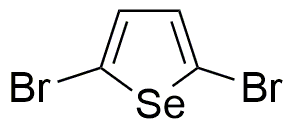2,5-Dibromoselenophene is widely utilized in research focused on:
- Organic Electronics: This compound is used in the development of organic semiconductors, which are crucial for creating flexible electronic devices such as OLEDs (Organic Light Emitting Diodes) and organic solar cells. Its unique electronic properties enhance device performance.
- Material Science: It serves as a building block for synthesizing advanced materials, including polymers and nanomaterials. These materials are essential in creating lightweight, high-strength composites for aerospace and automotive applications.
- Pharmaceutical Research: The compound is explored for its potential biological activities, including antimicrobial and anticancer properties. Researchers are investigating its efficacy in drug formulations, which could lead to new therapeutic options.
- Sensors: 2,5-Dibromoselenophene is employed in the fabrication of chemical sensors, particularly for detecting environmental pollutants. Its sensitivity and selectivity make it valuable for monitoring air and water quality.
- Photovoltaic Applications: This chemical is being studied for its role in improving the efficiency of dye-sensitized solar cells. Its ability to enhance light absorption can lead to more effective energy conversion technologies.
General Information
Properties
Safety and Regulations
Applications
2,5-Dibromoselenophene is widely utilized in research focused on:
- Organic Electronics: This compound is used in the development of organic semiconductors, which are crucial for creating flexible electronic devices such as OLEDs (Organic Light Emitting Diodes) and organic solar cells. Its unique electronic properties enhance device performance.
- Material Science: It serves as a building block for synthesizing advanced materials, including polymers and nanomaterials. These materials are essential in creating lightweight, high-strength composites for aerospace and automotive applications.
- Pharmaceutical Research: The compound is explored for its potential biological activities, including antimicrobial and anticancer properties. Researchers are investigating its efficacy in drug formulations, which could lead to new therapeutic options.
- Sensors: 2,5-Dibromoselenophene is employed in the fabrication of chemical sensors, particularly for detecting environmental pollutants. Its sensitivity and selectivity make it valuable for monitoring air and water quality.
- Photovoltaic Applications: This chemical is being studied for its role in improving the efficiency of dye-sensitized solar cells. Its ability to enhance light absorption can lead to more effective energy conversion technologies.
Documents
Safety Data Sheets (SDS)
The SDS provides comprehensive safety information on handling, storage, and disposal of the product.
Product Specification (PS)
The PS provides a comprehensive breakdown of the product’s properties, including chemical composition, physical state, purity, and storage requirements. It also details acceptable quality ranges and the product's intended applications.
Certificates of Analysis (COA)
Search for Certificates of Analysis (COA) by entering the products Lot Number. Lot and Batch Numbers can be found on a product’s label following the words ‘Lot’ or ‘Batch’.
*Catalog Number
*Lot Number
Certificates Of Origin (COO)
This COO confirms the country where the product was manufactured, and also details the materials and components used in it and whether it is derived from natural, synthetic, or other specific sources. This certificate may be required for customs, trade, and regulatory compliance.
*Catalog Number
*Lot Number
Safety Data Sheets (SDS)
The SDS provides comprehensive safety information on handling, storage, and disposal of the product.
DownloadProduct Specification (PS)
The PS provides a comprehensive breakdown of the product’s properties, including chemical composition, physical state, purity, and storage requirements. It also details acceptable quality ranges and the product's intended applications.
DownloadCertificates of Analysis (COA)
Search for Certificates of Analysis (COA) by entering the products Lot Number. Lot and Batch Numbers can be found on a product’s label following the words ‘Lot’ or ‘Batch’.
*Catalog Number
*Lot Number
Certificates Of Origin (COO)
This COO confirms the country where the product was manufactured, and also details the materials and components used in it and whether it is derived from natural, synthetic, or other specific sources. This certificate may be required for customs, trade, and regulatory compliance.

